I’ve always been fascinated by bread rising. Too intimidated to try making my own bread, but fascinated just the same :) This post is about my first attempt at homemade bread and what The Babe and I learned. It really wasn’t that hard and I quickly figured out that yeast is the magic in the biology of bread. How does it all work? Let’s start baking and learning!
I picked this Amish White Bread from allrecipes for my first attempt. Not because I don’t love me some wheat bread or crusty sourdough or airy ciabatta, I just thought plain white bread would be the easiest. The Amish bread is easy to make, a bit sweet and The Babe could not get enough of it, so I highly recommend this recipe.
What is Yeast?
Yeasts are single cell microorganisms in the Fungi kingdom. Yeasts are important in the world of baking, alcohol production and even the pharmaceutical industry as they help scientists create new medicines. Yeasts survive by eating carbohydrates like fructose, glucose and use their enzymes to break the sugars down into usable components. This sugar breakdown is called fermentation and converts carbohydrates to carbon dioxide (CO2) and alcohols.
Here are some pictures of the fermentation process of baker’s yeast proofing. First you see the dry yeast, then the yeast mixed with water and sugar (carbohydrate food) and finally the yeast after about 5 minutes. You can see how the yeast has released carbon dioxide from the bubbles it created. And when you try it yourself, you can smell the alcohol in the brew!
What Makes Bread Dough Rise?
Now that you know what yeast is, how does yeast work in bread? You know all that carbon dioxide you saw in the bubbly yeast brew? Those CO2 bubbles create gas pockets in the dough that help the bread dough rise. When the bread goes into the oven, the yeast continues releasing CO2 and the gases keep expanding because of the heat. But it’s kind of like chewing gum. If the bread doesn’t have a strong, elastic network, the bubbles will pop. The flour in the bread creates just the right kind of elastic material to keep those bubbles from popping. Check out the difference in the dough volumes below after just half an hour of fermentation.
What is Gluten and Why is it in Bread?
Wheat flour’s elastic network is made up of two proteins from the grain’s endosperm. These proteins, glutenin and gliadin, are called gluten when they combine. Mixing gluten with water in bread dough forms a gum-like stretchy substance that can hold gas bubbles. We knead the dough to help the gluten network become more and more elastic. The elasticity increases because kneading 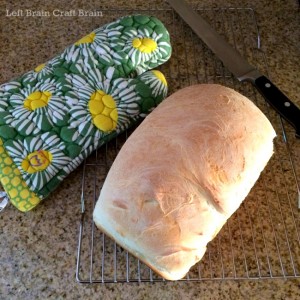
Bakers are experimenting with new gluten free elastic networks for baked goods as gluten sensitivities and allergies are becoming more prevalent. It takes a mixture of these replacements to match the unique characteristics of wheat. Standard wheat flour can be replaced with mixtures of things like potato starch, garbanzo flour, tapioca flour and sorghum flour.
Learning While Cooking
I’m telling you, this was my family’s favorite Left Brain Craft Brain project so far. Don’t be intimidated by making bread like I was! Even the first loaf that wasn’t as pretty as some of these pictures still tasted pretty dang good :) If you or your kids like learning while cooking (or ummm, eating while learning) check out some of my other food education projects like Polymer Science 101: Homemade Fruit Gummies or The Science of Ice Cream.
Love cookbooks like me? Here are some highly rated bread cookbooks to check out. {affiliate}

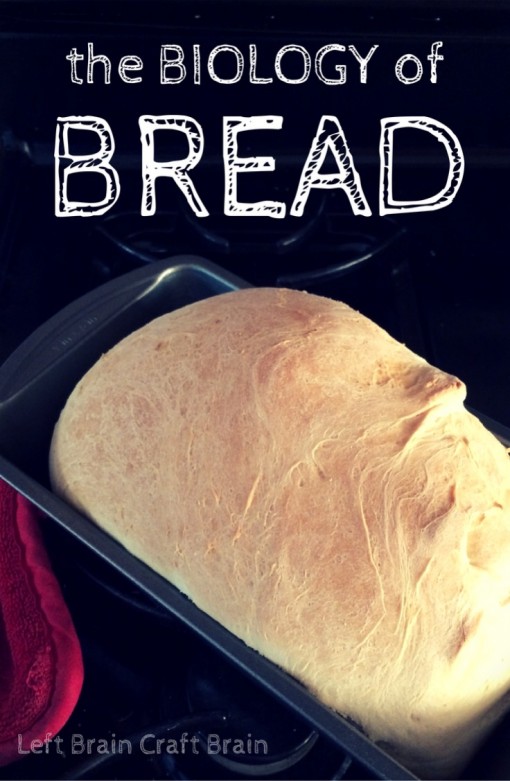
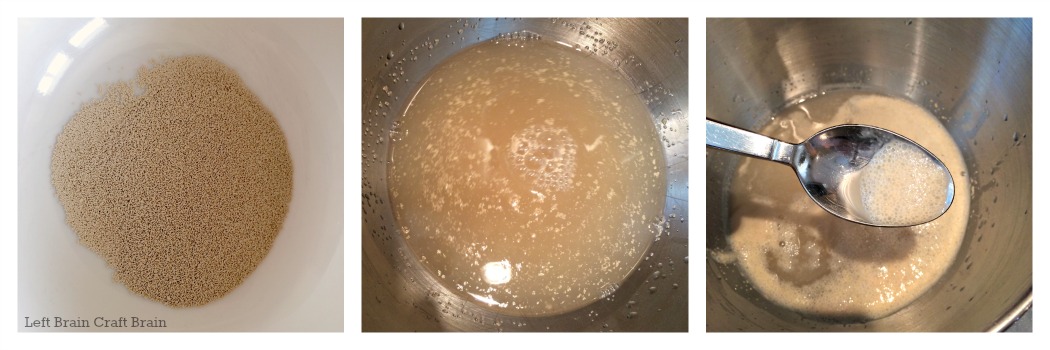
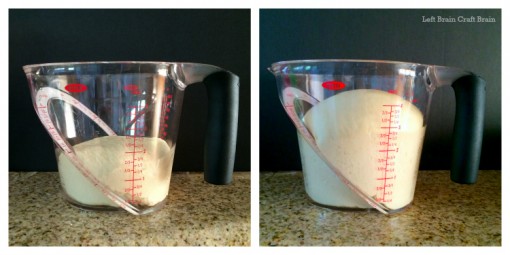
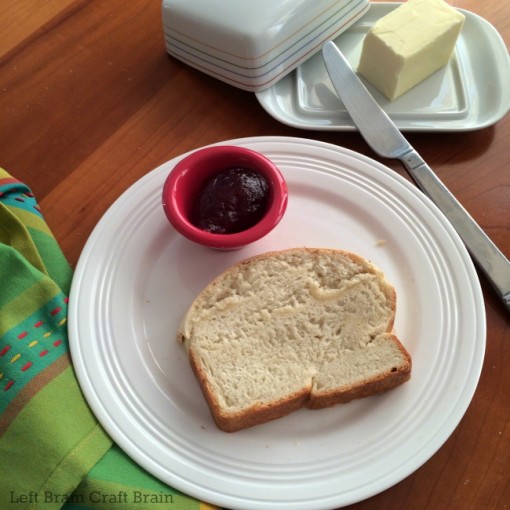

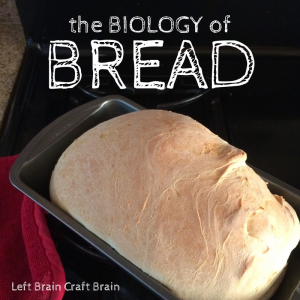
Pingback: STEM for Preschoolers + Love to Learn Linky (#6) - Left Brain Craft Brain
Pingback: 20 Quiet Time Activities for When Turkey Makes You Sleepy - Left Brain Craft Brain
Pingback: The Science of Thanksgiving Dinner - 12 Ways to Learn and Play - Left Brain Craft Brain
Pingback: Let’s Get Started! | Mrs. Adams Biology
Can you explain the biology of gluten free bread making? I understand about the CO2 and expansion in gluten bread, but getting that same reaction in gluten free bread is VERY difficult because the protein chains are different in the flour. I read in on one website about artificially producing the CO2 with baking soda and vinegar, but they didn’t explain the sequence of when you put in the baking soda and the yeast. Any ideas? Thanks
Hi Marsha! I’m not an expert on gluten free baking, but here’s a quick explanation. The process is actually the same in gluten free and regular flour bread. The yeast still creates CO2 when it ingests glucose from the other ingredients. The issue is that flour behaves like chewing gum in the bread and catches the CO2, stretches and makes the dough rise. Gluten free flours are not nearly as stretchy as wheat flour, therefore don’t rise as well. Many bakers will add something like xantham gum to gluten free bread to help create the stretchy network that holds the CO2 bubbles in. I’m guessing that adding vinegar and baking soda creates even more C02 so even if the flour network doesn’t stetch as much, there’s still plenty of bubbles in the bread. Hopes this helps!
I teach high school bio and am always looking for ways to make my curriculum more relevant. This post inspired me to add bread baking to our fungus unit. Can’t wait! Thanks!
So glad to hear that you’ll be using this in class! Makes my day :) Hope the kids enjoy it.
Pingback: Biology of Yogurt - Left Brain Craft Brain
Pingback: 25 Sensory Play STEM Learning Activities for Kids - Left Brain Craft Brain
Pingback: Awesome Pool Noodle Engineering Wall for Kids - Left Brain Craft Brain
Pingback: 5 Super Easy Snack Hacks for Active Preschoolers - Left Brain Craft Brain
Pingback: Thanksgiving Science and STEM Activities for Kids
Pingback: Biology for Kids|Fun with Fungus - Left Brain Craft Brain
Pingback: Start the New Year Off with STEAM: 12+ Activities to Try This Year - Left Brain Craft Brain
Pingback: Creative Learning in the Kitchen
Pingback: The ABC's of STEM for Preschool » Live Love Learn Gracefully
Pingback: 28 Edible Science Projects You’ll Actually Want to Eat | Education Discussion
Pingback: Brilliant Thanksgiving STEM Activities Kids Will Go Nuts For
Pingback: 25+ Easy and Awesome Science Projects for Kids - Left Brain Craft Brain
Pingback: Thanksgiving STEM Activities | Little Bins for Little Hands
Pingback: Brilliant Thanksgiving STEM Activities Kids Will Go Nuts For